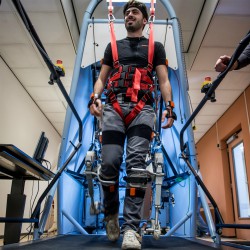Robotic exoskeletons get the balance right
Maintaining balance and avoiding falls can be very challenging for the elderly, spinal cord injury patients or workers performing difficult, strenuous tasks. Key examples are very common in the construction industry, lifting heavy loads, mountain rescue or simply for moving around if impaired physically. Exoskeletons available at the moment and their shortcomings The EU-funded BALANCE(opens in new window) (Balance Augmentation in Locomotion, through Anticipative, Natural and Cooperative control of Exoskeletons) project has researched and designed exoskeletons that provide support for standing and walking, while avoiding falls. ‘Future applications are foreseen in rehabilitation training and in advanced support of the elderly and, of course, in all such cases, falls should be avoided and balance maintained,’ states Dr Jan Veneman, project coordinator. Currently, state-of–the-art exoskeletons are used to provide mobility for paralysed spinal cord injured patients for short periods of time. Exoskeleton products provide weight support through the standing leg and swing motion to provide support in the swing leg. However, they don’t have any means to manage the overall posture or to maintain balance. In these cases, use of crutches, hand support bars, an overhead harness or even human assistance helps prevent a fall. BALANCE systems and novel robotics The main thrust of the BALANCE research was measuring human balance control and how to apply it in robotic systems. Algorithms incorporated loss of balance as measured in real time during movement. Novel robotic devices that pushed humans in a specific direction measured the components of balance control and how it was achieved. The researchers also modelled human balance and how people react to movement support. Completely new approaches where the exoskeleton provides zero resistance to the user (transparency control) and with head rotation initiating turning in position of the exoskeleton were developed. A first, researchers used an exoskeleton to successfully support reactive stepping to pushes while standing and walking. One major drawback of current wearable motion capturing systems is that metal structures, and electrical components distort their measurements. BALANCE, in collaboration, further developed a wearable motion capturing suit to be robust when faced with magnetic disturbances to overcome this problem. From the gait lab to the human-cooperative robotic exoskeleton arena Project researcher ingenuity was the driving force behind the EMY exoskeleton co-developed with other projects that suffered from substantial delays. A mitigation strategy had to be formulated, which involved replanning the whole of the second half of the project and the use of LOPES II and BAR-TM. Developed by other members of the consortium, LOPES II is a treadmill-based exoskeleton and BAR-TM is a pelvic support robot. Taking BALANCE deliverables into the movement rehabilitation centre, project results were used to assess and train balance in stroke patients via robotic devices developed from BALANCE research. The project also significantly contributed to various spin-off initiatives including the European Network on Wearable Robots(opens in new window), safety standards under the International Organisation for Standardisation and the International Electrotechnical Commission for personal care and medical applications of exoskeletons and the establishment of a benchmarking network(opens in new window) in Europe. 'Concrete steps towards commercialisation together with patents have been obtained for three solutions – the magnetic-immune motion capturing suit, the algorithms to measure quality-of-balance in real-time, and BAR for balance assessment and training in stroke rehab,' explains Dr Veneman. 'Now the project has finished, every partner will proceed with development of their own contributions to the BALANCE project.' Dr Veneman’s view of the future for robotics in this rapidly expanding area is that 'The ultimate goal is to have the exoskeleton seamlessly cooperate with the human user.'







